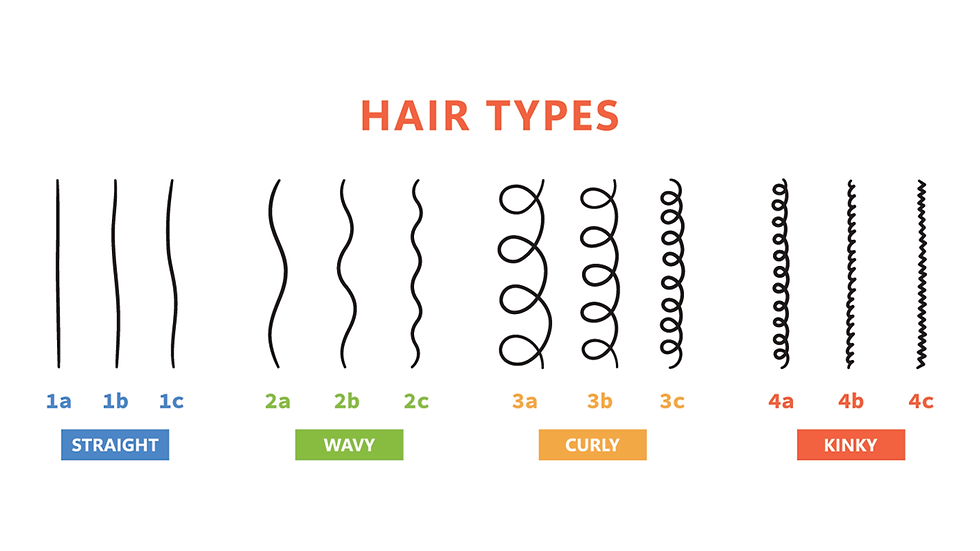Understanding Hair Types: The Key to Loving Your Natural Hair
- Gift Ndukwu
- Jan 28
- 3 min read
My Hair Journey
Growing up, I didn’t understand why my hair was so different from my peers’. I remember one day trying to straighten my 4c hair, only for it to defy gravity by lunch time. I thought my hair was “difficult,” but it was just doing what curly, coily, and kinky hair does best. Learning about my Type 4 curls was the turning point—it gave me the confidence to experiment, care for, and celebrate my natural hair.
Fast forward to today, and I’ve learned to embrace and celebrate the uniqueness of natural hair. One of the first steps to truly loving your hair is understanding its texture and type. Knowing your hair type isn’t just about labels; it’s the key to making informed decisions about how to care for your hair, which products to use, and what styles work best. Let’s dive into the wonderful world of hair types!

The Hair Type
The hair typing system is divided into four main categories, each with subcategories based on curl pattern, density, porosity, and thickness.
Type 1: Straight Hair
• 1A: Fine, flat, and silky. Think glassy-smooth strands that resist curls.
• 1B: Straight but with a little more body.
• 1C: Coarser and slightly wavy at the ends.
Type 2: Wavy Hair
• 2A: Loose, barely-there waves that are easy to straighten.
• 2B: S-shaped waves with a touch of frizz.
• 2C: Defined waves that border on curls, with more volume and frizz.
Type 3: Curly Hair
• 3A: Large, loose curls with a soft bounce.
• 3B: Tighter, springy curls with more volume and density.
• 3C: Corkscrew curls with lots of definition and shrinkage.
Type 4: Coily/Kinky Hair
• 4A: Tightly coiled S-shaped curls.
• 4B: Z-shaped curls with less definition and more volume.
• 4C: The tightest curls with a lot of shrinkage and no defined curl pattern.
For those with dry hair, it is important to look for products that provide intense hydration and nourishment to replenish moisture levels. Natural hair oils are perfect for this hair type as they can help restore shine and softness to your hair. Look for oils infused with ingredients like coconut, argan, or jojoba oil to deeply moisturize and repair dry and damaged hair.
If you have oily hair, opt for lightweight products that won't weigh your hair down or make it greasy. Clarifying shampoos and volumizing conditioners can help control excess oil production and leave your hair looking fresh and clean. Avoid heavy styling products and opt for oil-free formulas to keep your hair looking bouncy and oil-free.

Why Knowing Your Hair Type MATTERS
Understanding your hair type can change the game when it comes to hair care. Here’s why:
Product Selection: The right products can make or break your routine. For example, heavier creams work wonders for 4C hair, while lighter gels are better for 2A waves.
Styling Tips: Certain hairstyles work better for specific hair types. Twist-outs might be a dream for 4B hair but could fall flat on 1A strands.
Hair Health: Knowing your type helps you understand your hair’s moisture and protein needs. Curly and coily hair often craves moisture, while straighter textures may need a balanced approach.
Tips for Embracing Your Hair Type
Educate Yourself: Dive into resources, talk to hairstylists, and experiment with products.
Embrace Moisture: Especially for curlier textures, hydration is key. Use leave-ins, deep conditioners, and oils like my very own Gigi’s Root Boost!
Be Patient: Learning what works for your hair takes time. Be kind to yourself and enjoy the process.
Build a Routine: Create a hair care schedule that fits your texture’s needs.
Final Thoughts
Your hair is a reflection of your unique beauty and heritage. Whether it’s straight, wavy, curly, or kinky, every strand has a story to tell. Understanding your hair type is just the beginning of a lifelong love story with your natural hair.
To my younger self and anyone still figuring it out: your hair isn’t trying to misbehave—it’s just expressing its individuality. Embrace it, learn about it, and most importantly, love it.
What’s your hair type, and how has your journey been so far? Let me know in the comments—I’d love to hear your story!


Comments